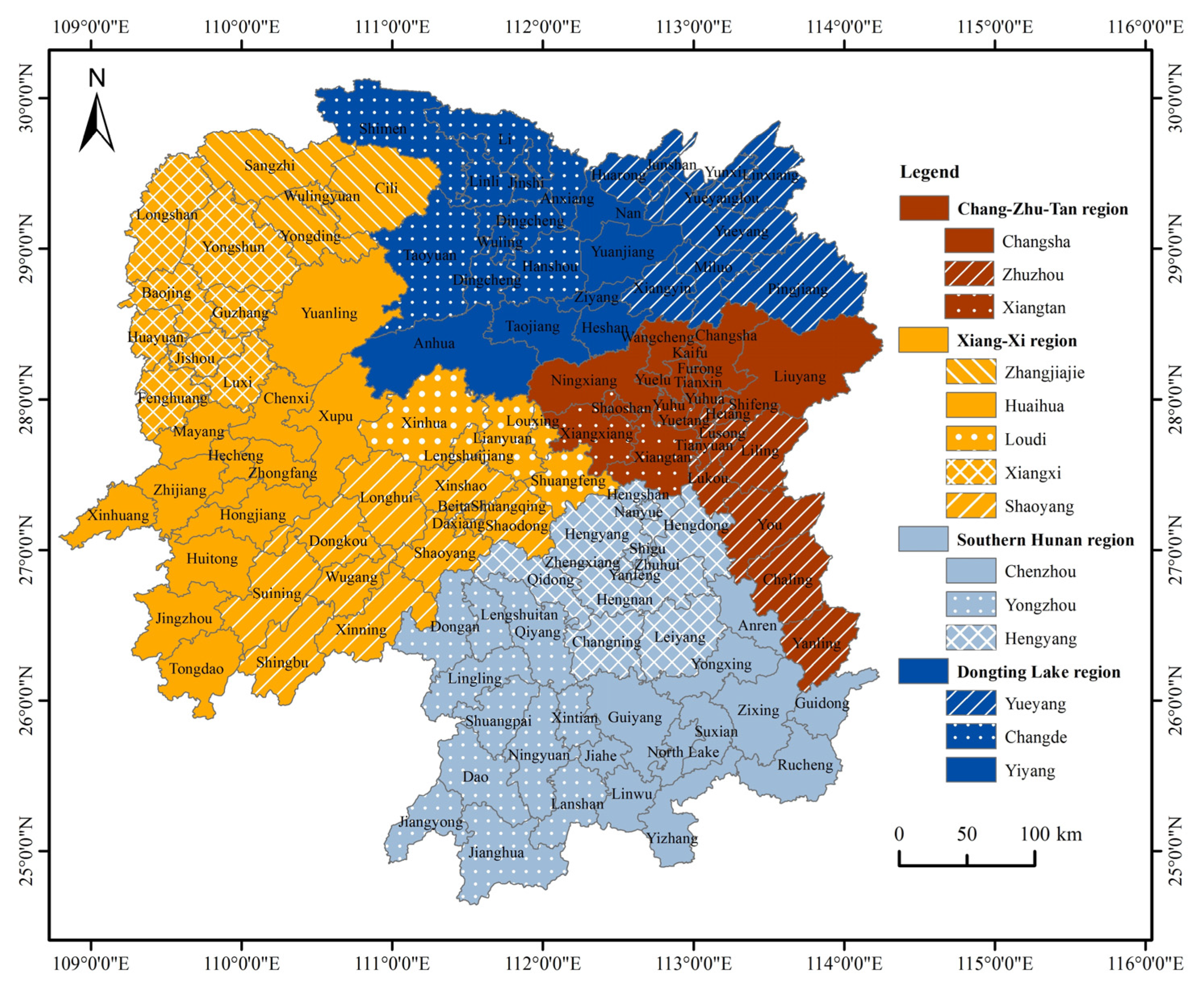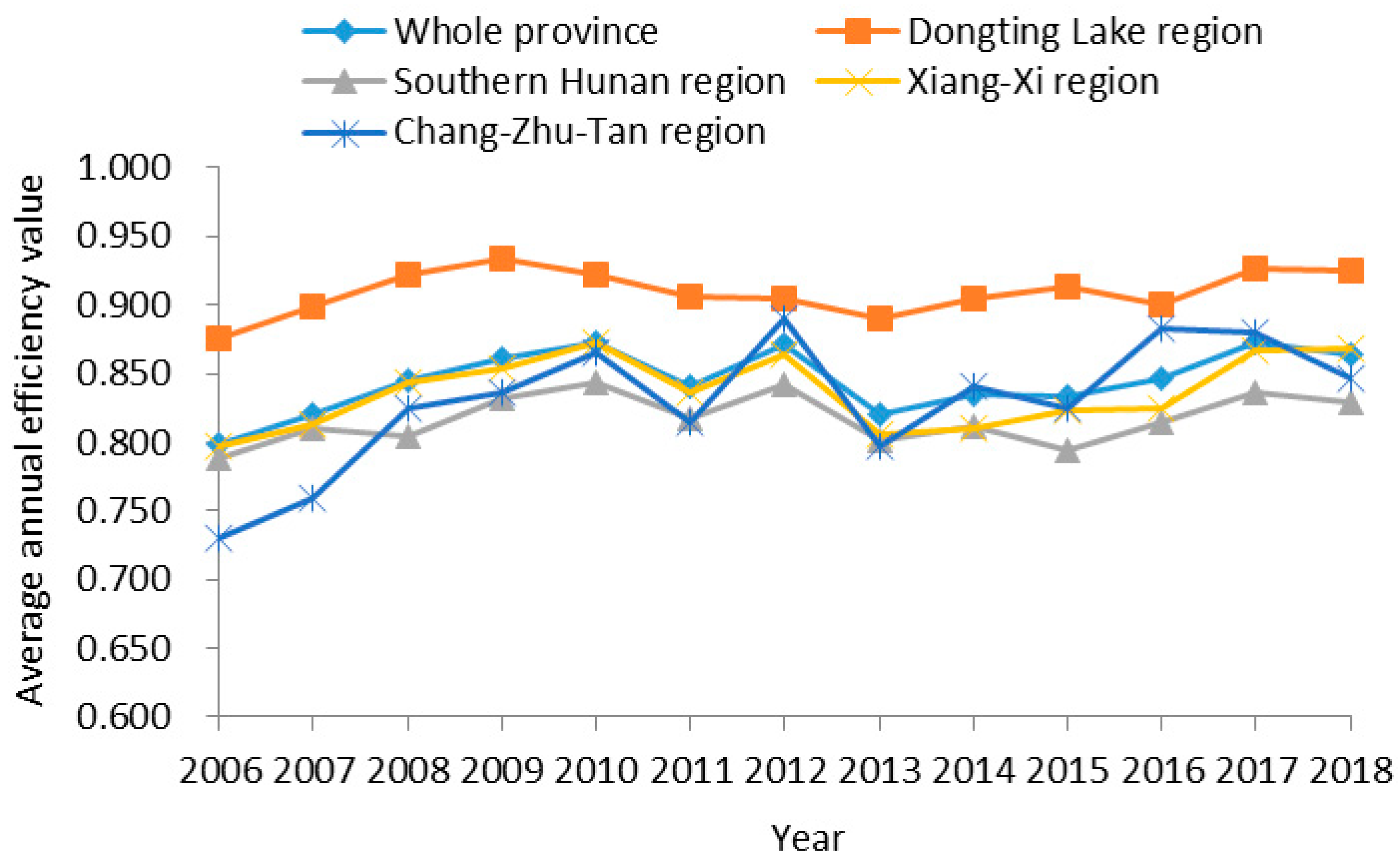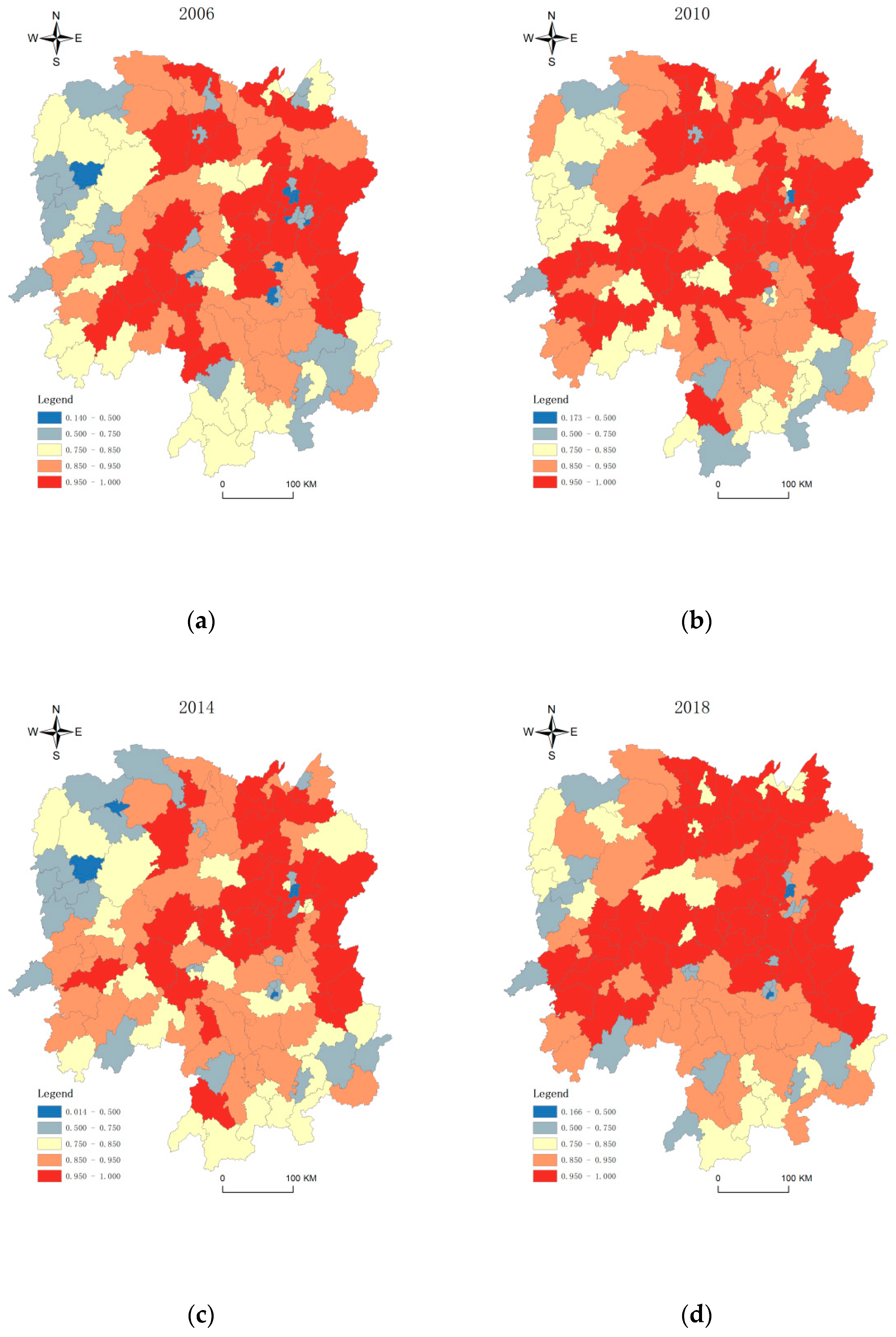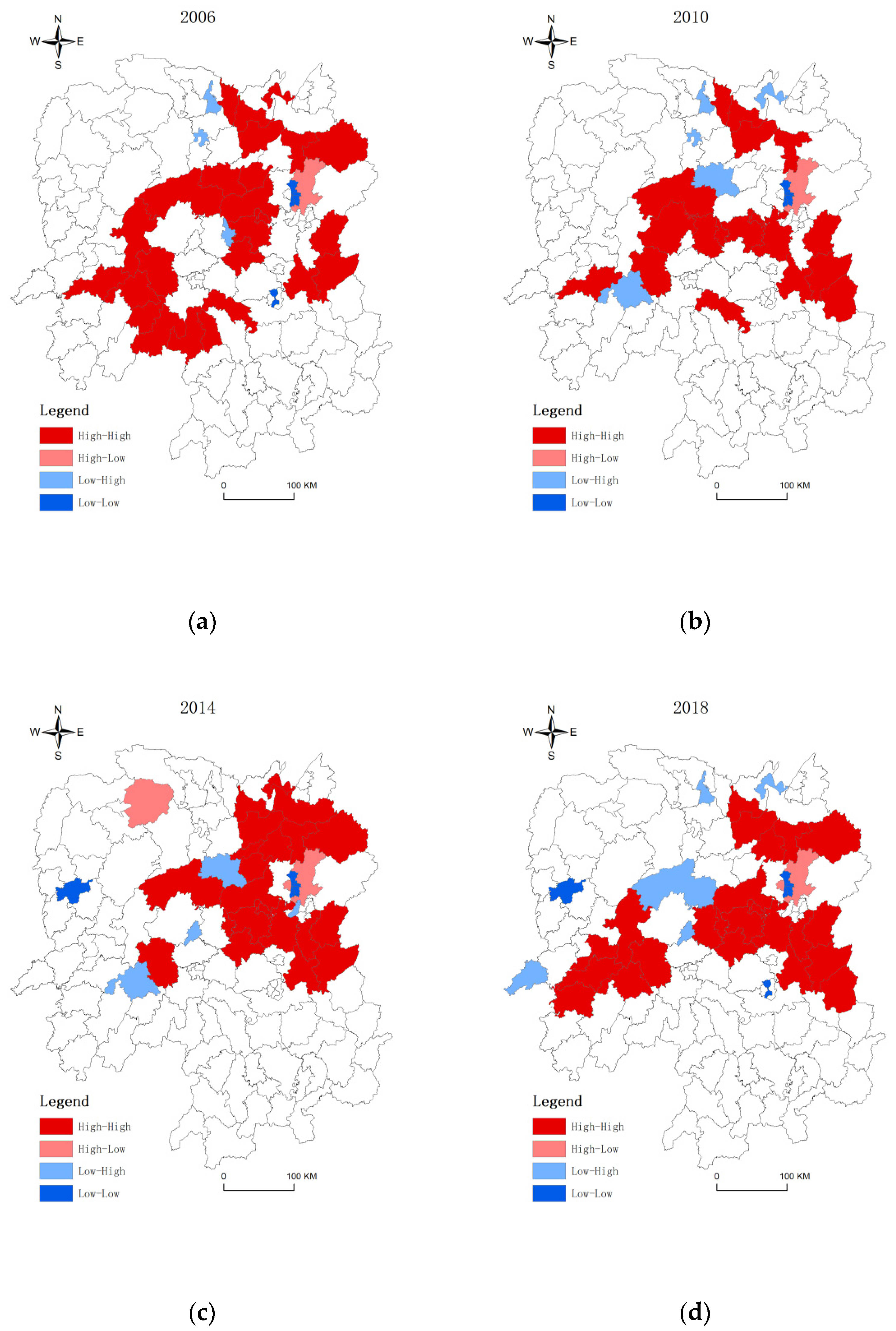Spatiotemporal Evolution and Antecedents of Rice Production Efficiency: From a Geospatial Approach
Abstract
:1. Introduction
2. Materials and Methods
2.1. Research Area and Datasets
2.2. Methods
2.2.1. Three-Stage DEA Model
2.2.2. Spatial Autocorrelation Analysis Model
2.2.3. Geographic Detector Model
2.3. Variable Selection and Descriptive Statistics
3. Results
3.1. Analysis of Spatiotemporal Evolution Characteristics and Aggregation Pattern of Rice Production Efficiency
3.1.1. Space and Temporal Evolution Characteristics Analysis of Rice Production Efficiency
3.1.2. Spatiotemporal Clustering Pattern Analysis of Rice Production Efficiency
3.2. Analysis on Influencing Factors of Spatiotemporal Variation of Rice Production Efficiency
3.2.1. Analysis on Influencing Factors of Spatiotemporal Differentiation of Rice Production Efficiency at Provincial Scale
3.2.2. Analysis on Influencing Factors of Spatiotemporal Variation of Rice Production Efficiency at Regional Scale
4. Conclusions and Discussion
5. Paper Limitations and Prospective Future Research
Author Contributions
Funding
Data Availability Statement
Acknowledgments
Conflicts of Interest
References
- Hou, M.; Deng, Y.; Yao, S. Spatial Agglomeration Pattern and Driving Factors of Grain Production in China since the Reform and Opening Up. Land 2021, 10, 10. [Google Scholar] [CrossRef]
- Li, H.; Wu, Y.; Huang, X.; Sloan, M.; Skitmore, M. Spatial-temporal evolution and classification of marginalization of cultivated land in the process of urbanization. Habitat Int. 2017, 61, 1–8. [Google Scholar] [CrossRef] [Green Version]
- Gao, H.; Zhang, Y.; Xu, C.; Yang, Y. Towards a Sustainable Grain Production Network: An Empirical Study from Northeast China. Sustainability 2022, 14, 8849. [Google Scholar] [CrossRef]
- Zhang, Y.; Li, B. Detection of the Spatio-Temporal Differentiation Patterns and Influencing Factors of Wheat Production in Huang-Huai-Hai Region. Foods 2022, 11, 1617. [Google Scholar] [CrossRef] [PubMed]
- Chen, W.; Zhang, B.; Kong, X.; Wen, L.; Liao, Y.; Kong, L. Soybean Production and Spatial Agglomeration in China from 1949 to 2019. Land 2022, 11, 734. [Google Scholar] [CrossRef]
- Li, S.; Zhang, D.; Xie, Y.; Yang, C. Analysis on the spatio-temporal evolution and influencing factors of China’s grain production. Environ. Sci. Pollut. Res. 2022, 29, 23834–23846. [Google Scholar] [CrossRef]
- Kusnandar, K.; Brazier, F.M.; van Kooten, O. Empowering change for sustainable agriculture: The need for participation. Int. J. Agric. Sustain. 2019, 17, 271–286. [Google Scholar] [CrossRef] [Green Version]
- Long, H.; Tu, S.; Ge, D.; Li, T.; Liu, Y. The allocation and management of critical resources in rural China under restructuring: Problems and prospects. J. Rural Stud. 2016, 47, 392–412. [Google Scholar] [CrossRef] [Green Version]
- Wang, Y.; Gao, F.; Gao, G.; Zhao, J.; Wang, X. Production and Cultivated Area Variation in Cereal, Rice, Wheat and Maize in China (1998–2016). Agronomy 2019, 9, 222. [Google Scholar] [CrossRef] [Green Version]
- Bao, B.; Jiang, A.; Jin, S.; Zhang, R. The Evolution and Influencing Factors of Total Factor Productivity of Grain Production Environment: Evidence from Poyang Lake Basin, China. Land 2021, 10, 606. [Google Scholar] [CrossRef]
- Duan, P.; Qin, L.; Wang, Y.; He, H. Spatiotemporal Correlations between Water Footprint and Agricultural Inputs: A Case Study of Maize Production in Northeast China. Water 2015, 7, 4026–4040. [Google Scholar] [CrossRef] [Green Version]
- Islam, A.; Shen, S.; Yang, S.; Hu, Z.; Rahman, M. Spatiotemporal rice yield variations and potential agro-adaptation strategies in Bangladesh: A biophysical modeling approach. Sustain. Prod. Consump. 2020, 24, 121–138. [Google Scholar] [CrossRef]
- Jin, T.; Zhong, T. Changing rice cropping patterns and their impact on food security in southern China. Food Secur. 2022, 14, 907–917. [Google Scholar] [CrossRef]
- Shi, W.; Lu, C.; Shi, X.; Cui, J. Patterns and trends in grain self-sufficiency on the Tibetan Plateau during 1985–2016. J. Geogr. Sci. 2020, 30, 1590–1602. [Google Scholar] [CrossRef]
- Luo, X.; Ao, X.; Zhang, Z.; Wan, Q.; Liu, X. Spatiotemporal variations of cultivated land use efficiency in the Yangtze River Economic Belt based on carbon emission constraints. J. Geogr. Sci. 2020, 30, 535–552. [Google Scholar] [CrossRef]
- Hossain, M.; Kamil, A.; Baten, M.; Mustafa, A. Stochastic Frontier Approach and Data Envelopment Analysis to Total Factor Productivity and Efficiency Measurement of Bangladeshi Rice. PLoS ONE 2012, 7, e46081. [Google Scholar] [CrossRef] [Green Version]
- Jalilov, S.; Mainuddin, M.; Maniruzzaman, M.; Mahbubul, A.; Towfiqul, I. Efficiency in the Rice Farming: Evidence from Northwest Bangladesh. Agriculture 2019, 9, 245. [Google Scholar] [CrossRef] [Green Version]
- Sun, Z.; Li, X. Technical Efficiency of Chemical Fertilizer Use and Its Influencing Factors in China’s Rice Production. Sustainability 2021, 13, 1155. [Google Scholar] [CrossRef]
- Yu, X.; Yin, X.; Liu, Y.; Li, D. Do Agricultural Machinery Services Facilitate Land Transfer? Evidence from Rice Farmers in Sichuan Province, China. Land 2021, 10, 466. [Google Scholar] [CrossRef]
- Wang, Y.; Huang, J.; Wang, J.; Christopher, F. Mitigating rice production risks from drought through improving irrigation infrastructure and management in China. Aust. J. Agric. Resour. Econ. 2018, 62, 161–176. [Google Scholar] [CrossRef]
- Ge, X.; Zhu, F.; Yang, Y.; Liu, G.; Chen, F. Probing Influence Factors of Implementation Patterns for Sustainable Land Consolidation: Insights from Seventeen Years of Practice in Jiangsu Province, China. Sustainability 2020, 12, 3576. [Google Scholar] [CrossRef]
- Wagan, S.; Memon, Q.; Li, Q.; Luan, J. Measuring the efficiency of Pakistani rice production via stochastic frontier and data envelopment analyses. Custos Agronegocio 2019, 15, 63–86. [Google Scholar]
- Griffith, D.; Chun, Y. Spatial Autocorrelation and Uncertainty Associated with Remotely-Sensed Data. Remote Sens. 2016, 8, 535. [Google Scholar] [CrossRef] [Green Version]
- Guo, B.; He, D.; Zhao, X.; Zhang, Z.; Dong, Y. Analysis on the spatiotemporal patterns and driving mechanisms of China’s agricultural production efficiency from 2000 to 2015. Phys. Chem. Earth 2020, 120, 102909. [Google Scholar] [CrossRef]
- National Bureau of Statistics. China Statistical Yearbook 2007–2019. Available online: http://www.stats.gov.cn/tjsj/ndsj/ (accessed on 6 May 2022).
- Hunan Provincial Bureau of Statistics. Hunan Rural Statistical Yearbook 2007–2019. Available online: http://tjj.hunan.gov.cn/hntj/tjsj/index.html (accessed on 6 May 2022).
- Hunan Provincial Bureau of Statistics. Hunan Statistical Yearbook 2007–2019. Available online: http://tjj.hunan.gov.cn/hntj/tjsj/tjnj/index.html (accessed on 6 May 2022).
- Hunan Provincial Bureau of Statistics. Hunan Finance Statistical Yearbook 2007–2019. Available online: http://tjj.hunan.gov.cn/hntj/tjsj/tjnj/index.html (accessed on 6 May 2022).
- Charnes, A.; Cooper, W.; Rhodes, E. Measuring the efficiency of decision making units. Eur. J. Oper. Res. 1978, 2, 429–444. [Google Scholar] [CrossRef]
- Fried, H.; Lovell, C.; Schmidt, S.; Yaisawarng, S. Accounting for environmental effects and statistical noise in data envelopment analysis. J. Prod. Anal. 2002, 17, 157–174. [Google Scholar] [CrossRef]
- Azizi, H. DEA efficiency analysis: A DEA approach with double frontiers. Int. J. Syst. Sci. 2014, 45, 2289–2300. [Google Scholar] [CrossRef]
- Pan, Z.; Tang, D.; Kong, H.; He, J. An Analysis of Agricultural Production Efficiency of Yangtze River Economic Belt Based on a Three-Stage DEA Malmquist Model. Int. J. Environ. Res. Public Health 2022, 19, 958. [Google Scholar] [CrossRef]
- Jiang, M.; Qi, C. Measurement and Analysis of Agricultural Production Efficiency in Taiwan of China Based on Three-stage DEA Model. Asian Agric. Res. 2018, 10, 7. [Google Scholar]
- Chen, Y. An analytical process of spatial autocorrelation functions based on Moran’s index. PLoS ONE 2021, 16, e0249589. [Google Scholar] [CrossRef]
- Ji, J.; Tang, Z.; Wang, L.; Liu, W.; Shifaw, E.; Zhang, W.; Guo, B. Spatiotemporal Analysis of the Coupling Coordination Degree between Haze Disaster and Urbanization Systems in China from 2000 to 2020. Systems 2022, 10, 150. [Google Scholar] [CrossRef]
- Wang, Q.; Jiang, D.; Gao, Y.; Zhang, Z.; Chang, Q. Examining the Driving Factors of SOM Using a Multi-Scale GWR Model Augmented by Geo-Detector and GWPCA Analysis. Agronomy 2022, 12, 1697. [Google Scholar] [CrossRef]
- Zhang, Q.; Shi, F.; Abdullahi, N.; Shao, L.; Huo, X. An empirical study on spatial-temporal dynamics and influencing factors of apple production in China. PLoS ONE 2020, 15, e0240140. [Google Scholar] [CrossRef] [PubMed]
- Yin, G.; Lin, Z.; Jiang, X.; Yan, H.; Wang, X. Spatiotemporal differentiations of arable land use intensity—A comparative study of two typical grain producing regions in northern and southern China. J. Clean. Prod. 2019, 208, 1159–1170. [Google Scholar] [CrossRef]
- Zhang, D.; Wang, H.; Lou, S. Research on grain production efficiency in China’s main grain-producing areas from the perspective of grain subsidy. Environ. Technol. Innov. 2021, 22, 101530. [Google Scholar] [CrossRef]
- Lu, L.; Chiu, S.; Chiu, Y.; Chang, T. Three-stage circular efficiency evaluation of agricultural food production, food consumption, and food waste recycling in EU countries. J. Clean. Prod. 2022, 343, 130870. [Google Scholar] [CrossRef]
- Ma, L.; Long, H.; Tang, L.; Tu, S.; Zhang, Y. Analysis of the spatial variations of determinants of agricultural production efficiency in China. Comput. Electron. Agric. 2021, 180, 105890. [Google Scholar] [CrossRef]
- Yu, D.; Hu, S.; Tong, L.; Xia, C. Spatiotemporal Dynamics of Cultivated Land and Its Influences on Grain Production Potential in Hunan Province, China. Land 2020, 9, 510. [Google Scholar] [CrossRef]
- Sun, Y.; Chang, Y.; Liu, J.; Ge, X.; Liu, G. Spatial Differentiation of Non-Grain Production on Cultivated Land and Its Driving Factors in Coastal China. Sustainability 2021, 13, 13064. [Google Scholar] [CrossRef]
- Cai, J.; Ma, E.; Lin, J.; Liao, L.; Han, Y. Exploring global food security pattern from the perspective of spatio-temporal evolution. J. Geogr. Sci. 2020, 30, 179–196. [Google Scholar] [CrossRef]




| Regions | Districts | Counties |
|---|---|---|
| Dongting Lake | Yueyang | Miluo, Linxiang, Yueyang, Pingjiang, Xiangyin, Huarong, Yueyang lou, Yunxi, Junshan |
| Changde | Jinshi, Anxiang, Hanshou, Li, Linli, Taoyuan, Shimen, Wuling, Dingcheng | |
| Yiyang | Yuanjiang, Nan, Taojiang, Anhua, Ziyang, Heshan | |
| Southern Hunan | Hengyang | Leiyang, Changning, Hengyang, Hengnan, Hengshan, Hengdong, Qidong, Zhuhui, Yanfeng, Shigu, Zhengxiang, Nanyue |
| Chenzhou | Zixing, Guiyang, Yongxing, Yizhang, Jiahe, Linwu, Rucheng, Guidong, Anren, Beihu, Suxian | |
| Yongzhou | Dongan, Dao, Ningyuan, Jiangyong, Jianghua, Lanshan, Xintian, Shuangpai, Qiyang, Lingling, Lengshuitan | |
| Xiang-Xi | Loudi | Lengshuijiang, Lianyuan, Shuangfeng, Xinhua, Louxing |
| Shaoyang | Wugang, Shaodong, Xinshao, Shaoyang, Longhui, Dongkou, Xinning, Suining, Chengbu, Shuangqing, Daxiang, Beita | |
| Huaihua | Hongjiang, Zhongfang, Yuanling, Chenxi, Xupu, Mayang, Huitong, Xinhuang, Zhijiang, Jingzhou, Tongdao, Hecheng | |
| Zhangjiajie | Cili, Sangzhi, Yongding, Wulingyuan | |
| Xiangxi | Jishou, Luxi, Fenghuang, Huayuan, Baojing, Guzhang, Yongshun, Longshan | |
| Chang-Zhu-Tan | Changsha | Liuyang, Ningxiang, Changsha, Furong, Tianxin, Yuelu, Kaifu, Yuhua, Wangcheng |
| Zhuzhou | Liling, You, Chaling, Yanling, Hetang, Shifeng, Lusong, Tianyuan, Lukou | |
| Xiangtan | Xiangxiang, Shaoshan, Xiangtan, Yuhu, Yuetang |
| Variables | Minimum | Maximum | Mean | SD |
|---|---|---|---|---|
| Rice yield | 191.00 | 886,698.00 | 218,892.39 | 187,497.09 |
| Planting area | 30.00 | 132,290.00 | 34,327.20 | 29,051.71 |
| Irrigation area | 30.00 | 86,320.00 | 23,586.05 | 18,612.76 |
| Fertilizer | 270.40 | 225,600.76 | 47,884.77 | 44,796.91 |
| Pesticide | 3.10 | 5324.17 | 717.62 | 797.04 |
| Mechanical power | 3895.33 | 1,544,854.06 | 274,402.51 | 253,978.65 |
| Practitioners | 1984.39 | 437,210.87 | 117,964.33 | 85,620.93 |
| The proportion of primary industry in GDP | 0.11 | 50.64 | 17.52 | 10.68 |
| Urbanization level | 12.41 | 99.83 | 48.94 | 22.22 |
| Rice minimum purchase price | 61.94 | 97.03 | 82.72 | 12.24 |
| Financial agriculture, forestry and water expenditure | 1.86 | 813.84 | 144.72 | 130.82 |
| Rice cropping index | 0.27 | 2.00 | 1.35 | 0.39 |
| Input | Planting Area | Irrigation Area | Fertilizer | Pesticide | Mechanical Power | Practitioners | |
|---|---|---|---|---|---|---|---|
| Output | |||||||
| Rice yield | 0.994 *** | 0.946 *** | 0.919 *** | 0.749 *** | 0.886 *** | 0.837 *** | |
| Detection Factors | 2006 | 2010 | 2014 | 2018 | ||||
|---|---|---|---|---|---|---|---|---|
| q | p | q | p | q | p | q | p | |
| The proportion of secondary industry in GDP | 0.1275 | 0.0170 | 0.0783 | 0.1170 | 0.0657 | 0.2635 | 0.0844 | 0.3651 |
| Per capita disposable income of farmers | 0.2880 | 0.0000 | 0.1990 | 0.1483 | 0.0821 | 0.0746 | 0.0305 | 0.7841 |
| Government expenditure on agriculture, forestry and water resources | 0.1363 | 0.9326 | 0.2697 | 0.8478 | 0.3004 | 0.0000 | 0.3462 | 0.0000 |
| Rice multiple cropping index | 0.1815 | 0.0026 | 0.1804 | 0.0000 | 0.2965 | 0.0000 | 0.1490 | 0.0318 |
| Detection Factors | Dongting Lake | Southern Hunan | Xiang-Xi | Chang-Zhu-Tan | ||||
|---|---|---|---|---|---|---|---|---|
| q | p | q | p | q | p | q | p | |
| The proportion of secondary industry in GDP | 0.1032 | 0.0176 | 0.2879 | 0.0000 | 0.0534 | 0.0064 | 0.0336 | 0.5096 |
| Per capita disposable income of farmers | 0.2212 | 0.0000 | 0.6547 | 0.0000 | 0.4587 | 0.0000 | 0.4545 | 0.0000 |
| Government expenditure on agriculture, forestry and water resources | 0.1691 | 0.0000 | 0.3067 | 0.0000 | 0.1431 | 0.0000 | 0.2758 | 0.0000 |
| Rice multiple cropping index | 0.2371 | 0.0256 | 0.3564 | 0.0000 | 0.1284 | 0.0072 | 0.3614 | 0.0000 |
Disclaimer/Publisher’s Note: The statements, opinions and data contained in all publications are solely those of the individual author(s) and contributor(s) and not of MDPI and/or the editor(s). MDPI and/or the editor(s) disclaim responsibility for any injury to people or property resulting from any ideas, methods, instructions or products referred to in the content. |
© 2023 by the authors. Licensee MDPI, Basel, Switzerland. This article is an open access article distributed under the terms and conditions of the Creative Commons Attribution (CC BY) license (https://creativecommons.org/licenses/by/4.0/).
Share and Cite
Zeng, X.; Li, Z.; Zeng, F.; Caputo, F.; Chin, T. Spatiotemporal Evolution and Antecedents of Rice Production Efficiency: From a Geospatial Approach. Systems 2023, 11, 131. https://doi.org/10.3390/systems11030131
Zeng X, Li Z, Zeng F, Caputo F, Chin T. Spatiotemporal Evolution and Antecedents of Rice Production Efficiency: From a Geospatial Approach. Systems. 2023; 11(3):131. https://doi.org/10.3390/systems11030131
Chicago/Turabian StyleZeng, Xiongwang, Zhisheng Li, Fusheng Zeng, Francesco Caputo, and Tachia Chin. 2023. "Spatiotemporal Evolution and Antecedents of Rice Production Efficiency: From a Geospatial Approach" Systems 11, no. 3: 131. https://doi.org/10.3390/systems11030131






